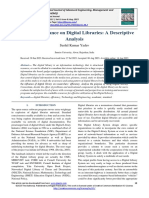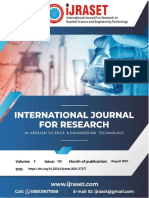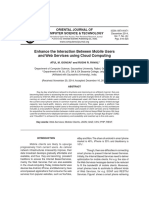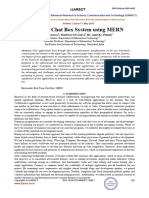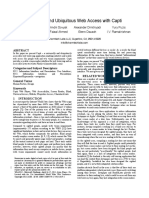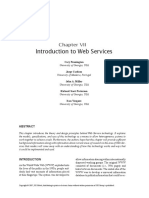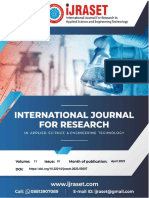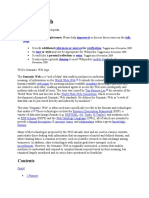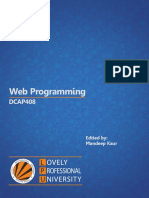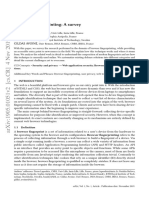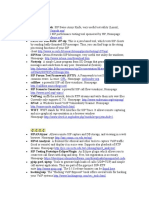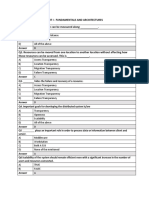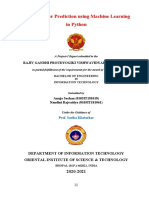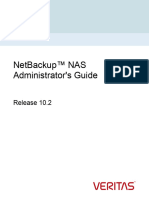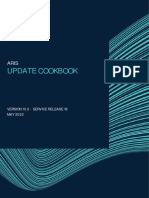Professional Documents
Culture Documents
Development of A Semantic Web Framework For The Blind
Original Title
Copyright
Available Formats
Share this document
Did you find this document useful?
Is this content inappropriate?
Report this DocumentCopyright:
Available Formats
Development of A Semantic Web Framework For The Blind
Copyright:
Available Formats
Volume 8, Issue 1, January – 2023 International Journal of Innovative Science and Research Technology
ISSN No:-2456-2165
Development of a Semantic Web
Framework for the Blind
1
akazue Maureen,
2
Comfort Ekpewu ,
3
edith Omede,
4
edje E. Abel
Department of Computer Science, Faculty of science, Delta State University Abraka
Abstract:- This research addresses some of the situation [1]. Simple data retrieval operations that would be
important issues related to web accessibility in the trivial to most users are comparatively complex for users
context of blind users. The problems of Web data who have a visual disability such as blindness or print
accessibility and navigation for blind users have become impairment. Blind users rely on tactile auditory output to
an active research field for the past decade. Many interact with computers; however, web pages are not
techniques have been created to solve them, some are designed with these access methods in mind. Users often
hardware-based and others are software based. Yet, the find themselves overwhelmed by complicated methods in
web is rapidly evolving toward the far-anticipated mind. Users usually find themselves overwhelmed by
Semantic Web (SW): a revolutionary vision extending complicated pages that are bloated with non-cohesive
Web information with well-defined meaning so that it information, lack structure, and are inconsistent with other
becomes more easily accessible by human users and pages on the same site [1].
automated processes. As a result, SW technological
breakthroughs such as ontologies and semantic data Assistive Technologies (ATs) such as screen readers
description, as well as data representation and employ the underlying document object model (DOM)
manipulation technologies (i.e RDF, OWL, and structure of a web page to narrate its contents to a blind user
SPARQL) are being recently explored to improve data [2];[3]. Web developers must follow the W3C and other
accessibility for blind Web surfers. This research, briefly criteria while designing websites to guarantee that ATs
explores existing studies targeting Web data accessibility perform properly. Unfortunately, due to a lack of
for blind users ranging from traditional techniques understanding among web developers, this need is not being
(Braille output, screen readers, etc.) to semantically satisfied adequately, and as a result, a huge amount of web
enhanced techniques (using Speech and alternative material remains unavailable to ATs and blind users. Web
speech-based interfaces for human-computer 2.0 has accelerated this trend by providing end users with
interaction). A semantic web for the blind was designed web authoring skills [4]; [2]. Thus, the goal of ATs is to
and implemented using JAVASCRIPT, HTML, CSS, disclose such inaccessible webpage information using
and MySQL. After the evaluation of the developed creative approaches and deliver them to blind users [2]. The
framework, the result of the research revealed that it has compelling need for more user friendly products as well as
load-time as 75%, success ratio of 0.93, repository size of the recent trends towards universal accessibility and greater
65%, and CPU-time up to 80% and comparing it to the usability of interactive applications is highly important [5].
existing performance evaluation, it can be said that the
proposed developed framework out performed. The problems such as stigmatization, difficulties in
web accessibility, and mobility are what motivated this
Keywords:- Semantic; Framework; Blind; Web; Interaction research. Due to the continuity of the blind persons
struggling with Web access as a result of the fact that most
I. INTRODUCTION webpages are increasingly reliant on visual content and
graphical design, even in the face of screen readers or
The internet is a vast resource that has increased the talking browsers [6], and in the high informality of the
availability of information by stratospheric proportions; declarative graphic representations that were used to
unfortunately, information availability is not proportional to represent knowledge and support automated systems is what
accessibility. The internet is overwhelmingly visual and the brought difficulties in web accessibility and mobility
advancement of multimedia on the web is not improving the according to [7].
IJISRT23JAN1148 www.ijisrt.com 1781
Volume 8, Issue 1, January – 2023 International Journal of Innovative Science and Research Technology
ISSN No:-2456-2165
Fig 1 The Semantic Web for the Data and Services on the Web [8].
Fig 2 The Workflow of a Semantic Web [9]
Fig 3 The Semantic Web RDF Core Ontology Repository [10].
IJISRT23JAN1148 www.ijisrt.com 1782
Volume 8, Issue 1, January – 2023 International Journal of Innovative Science and Research Technology
ISSN No:-2456-2165
The materials and findings of this research provides the and with large text so that they may be easily read by
awareness that blind users can surf the web. This was achieved those who are blind.
by providing an alternate speech-based interface for human-
computer interaction. This aids developers to incorporate speech These adaptive approaches allow developers to take
recognition while designing any program to aid blind users and advantage of the pre-existing functions present in an
create the most realistic method of utilizing the Internet for application, which they would not have the time or
their vital and routine tasks that will allow them to live resources to implement themselves. However, it can be
independently and with dignity. technically difficult to adapt a piece of software to perform a
different task to which it was originally intended, especially
II. METHODS AND MATERIALS ADOPTED if the code is highly complex or proprietary.
The research evaluated existing semantic web systems Hardware Based Techniques
and their techniques with a view to exposing their flaws These techniques provide the user with hardware
through in-depth literature review. The literature review was interfaces using the universal language Braille 1 (used by 2
followed by an analysis of how to apply better discovered out of 10 blind people). These are implemented through
features that will efficiently build a quality and easily devices like the Braille keyboard (data input) and Braille
accessible semantic web for the blind. A Javascript web- display (data output). Yet, such devices are generally
based framework which used easy simple setup rules and expensive, and need to be mounted and configured manually
intelligent keyboard keys detection scoring to achieve high on each computer system (e.g., PC, tablet, smartphone, etc.)
rates of internet usage among the blind. The semantic web to be utilized by the blind user.
framework designed for easy accessibility of the blind to
world-wide-web incorporated knowledge, best practices and
technology in mitigating the problem of stigmatization.
The developed framework incorporated the wide use of
ontology, meaningful semantics, suitable programming
language and best database tools for implementation to
ensure that the success ratio, CPU-time and load time are
not less than one. In other words, the proposed framework
used SAT which provided a common interface for service
providers (SPs) in order to register their services according
to the descriptors supported by the proposed framework
Fig 4 Main hardware accessibility techniques for blind users.
ontologies and integrating those procedures and techniques
that could be easily adopted under the current computing
environments with affordable consumption of resources. The Braille system is a method based on tactile
contact, widely used by blind people in order to read and
write text.
The framework developed is then tested, validated and
reviewed through its functionalities for future and
Software Based Techniques
improvement.
These techniques can be implemented on any basic
[11] explains how the existing tools for disabled users computer system and do not require special hardware:
are ``adaptive in nature'' so the methodology that would be Speech synthesizers are software tools that transform
used, would be adaptive methodology whose primary text-based input into (human) speech output.
purpose is to extend an existing piece of software to Screen readers (e.g., VoiceOver (mac), YASR (Linux),
incorporate some new functionality that improves disabled Tiny Voice (Dos)) are software tools that attempt to
user interaction. identify and interpret what is being displayed on the
screen of a computer: the text shown on screen is
Such Adaptations Can Be Categorized In Three Different straightforwardly transformed into audio (speech)
Levels: output, whereas images and other multimedia objects are
Alternative access adaptations extend an existing confined to their alternative text descriptions which are
solution to provide support for specialist input/output transformed into speech.
equipment such as Braille displays or screen magnifiers. Talking browsers are internet browsers that transform an
Information content adaptations involve modifying the input Webpage into an audio (speech-based) output
representation of data to make it more accessible. Such using speech synthesizers, providing some shortcuts
an adaptation may extend html to make it more (e.g., list of headings (insert+F6), list of links
accessible to text-to-speech engines by adding further (insert+F7). While some of these tools have been shown
descriptive tags to the visual elements of a page. efficient (such as WebTalkster, Word read, Browse-
User Interface adaptations involve changing the way aloud, yet they remain confined to reading text-only
users interact with an application in order to cater for the input that appears on the screen.
needs of a specific user group. Such an adaptation may
alter a web browser to render web pages without images
IJISRT23JAN1148 www.ijisrt.com 1783
Volume 8, Issue 1, January – 2023 International Journal of Innovative Science and Research Technology
ISSN No:-2456-2165
While the above software-based techniques have been user in audio or sound-based modality). They do not
shown practical and efficient, they were designed to provide however target data input.
data output only (transforming and presenting data to the
Fig 5 The overall architecture of the proposed system back-end system
III. IMPLEMENTATION The DMM supports the following operations:
It manages incoming requests for services. It processes
As soon as a request for service is launched by the the requests via a query engine that submits the
client user application, the DMM submits a semantic query appropriate semantic queries to the ontological
to the ontological framework in order to retrieve the framework. After processing the DMM request, the
appropriate service. The retrieved service is invoked by the ontology replies by a list of retrieved services and their
corresponding wrapper via SOAP messages exchange. locations.
It also performs invocation of real WSs via the
The data management module (DMM) handles corresponding wrapper, a client application, which is
incoming user requests for services. The DMM listens to the aware of the valid mappings that should occur between
request, decomposes it, searches for the appropriate services real WS data types and the ones defined in the ontology.
through the query engine and retrieves the service that best In this way, the wrapper becomes capable to invoke the
fulfils the user request. real service when receives a request for service
invocation in the common ontological format. It finally
In The Back-End System Architecture The Following wraps content returned by the previously invoked WS
Units Are Included: and sends it back to the user application in the common
SAT. This component provides a common interface for ontological format.
SPs in order to register their services according to the
descriptors supported by the ASK-IT ontologies. As Content exchange between DMM and real WSs is
soon as a new service is registered, its location is stored performed by appropriate messages defined in the Simple
in a service repository. Object Access Protocol (SOAP).
The ontological framework consists of the overall
ontology, which consists of a number of domain-specific The Service Alignment Tool
ontologies and the service repository. An ontology Service alignment is the process of registering an
author is granted access to the ontology in order to existing WS into the back-end subsystem of the proposed
perform modifications on it. The service repository acts framework so that it adheres to the ontological definitions of
as an index of services, which are linked to the ontology. services. This process is performed by any SP who is
The structure of the overall ontology and the separate interested to provide one or more services that deliver
domain-specific ontologies are presented in below. content in the one of the application domains and for those
user groups that are defined in the context of the proposed
project. Service alignment is facilitated by the SAT, which
is equipped with a web-based user-friendly interface, shown
IJISRT23JAN1148 www.ijisrt.com 1784
Volume 8, Issue 1, January – 2023 International Journal of Innovative Science and Research Technology
ISSN No:-2456-2165
in Figure 3. The aforementioned process results into the defined in the service ontology. SPs correlate their WSs
completion of service integration whose purpose is to enable with the ontologies. By doing so, WSs are consistently
the efficient invocation of services whenever it is requested marked up. The alignment mechanism facilitates a flexible
by any of the integrated client applications. standardization process.
Service Integration In this context, ‘similarity’ between the ontology and
SPs participate in the service alignment process by the WS is established when the following criteria are
being able to establish relationships between the services satisfied:
and the ontologies. WSs are described in the service the inputs of the supported WS operations are identical
ontology by the service model that defines the operations to the inputs provided by the service model’s operations
and the structure that should characterize any registered WS. the outputs of the real WS operations are described by
the outputs provided by the service model in the
Before the alignment takes place, SAT collects ontology.
information about the SPs. Any registered provider has the
ability to navigate through the supported models as these are
Fig 6 A snapshot of the SAT user interface
Notes: SPs may exploit drag-and-drop functionality in where P_id is the provider’s identifier, wsdl is the URI
order to provide mappings of data types and operations to the WSDL service description and, op is a list of defined
defined in their services to the corresponding fields. operations. Each operation is defined as:
The SAT allows any SP to see the ontological op =< name i, ,1 …, in, o >,
operations that are defined in similar manner to those where name is the name of the operation, i1, …, in its
appearing in a WSDL file. Furthermore, by clicking on the inputs and o its output.
operation models, SPs can get information about the inputs
and outputs that their services must have in order to comply Let us assume that service S is described in the
with the model. ontology by the service ontological representation Sm. Two
arbitrary operations op ∈ S and opm ∈ Sm have a degree of
After the identification of the appropriate model, the similarity equal to 1, when they have equal number of inputs
providers should select from a drop-down list the operation and also: ik ≡ imk and o ≡ om, ∀ik, o∈op and imk, om∈opm,
that complies with the service they want to register. Thus, where k = 1…n.
they provide the uniform resource identifier (URI) of the
WSDL file that describes the service. At this point, the tool The alignment process, which is performed by the
automatically parses the WSDL file and extracts the provider initially determines the degree of similarity
required information. In this context, any service can be between the operation defined in the ontology and the one
described by the triplet: that has been selected to be included as part of a registered
service. It is up to the SP to verify the accuracy of the
S =< P _id, wsdl, op[ ] >, alignment operation and select the service to be aligned.
IJISRT23JAN1148 www.ijisrt.com 1785
Volume 8, Issue 1, January – 2023 International Journal of Innovative Science and Research Technology
ISSN No:-2456-2165
The last step of the service alignment procedure access a WS, it should have the client stub code of the
involves mapping of inputs and outputs between the service integrated service, which provides the ability to call the
to be aligned and the proposed framework ontological service each time this is requested by the user interface.
service model. This process, which is supported by drag and
drop operations on the GUI is illustrated in the snapshot of Usage Scenarios
Figure 6. Once this final step is completed, the information In the framework, a wide range of services have been
of the alignment operation is stored in a registry of services, defined with respect to the following domains:
known as service repository. In this way, the invocation of transportation
services is enabled through the back-end system. The tourism and leisure
invocation mechanism handles incoming requests for personal support services
specific content by the client applications and launches the work, business and education
appropriate services in order to receive the required content. home automation
social relations and community building.
Service Invocation
As soon as a service alignment process is completed, All content, required for the implementation of the
the newly aligned service is integrated within the system’s various use cases, becomes available through a set of WSs.
back-end and at the same time a new entry is added in the The required content is being rendered on the user device,
service repository. Actual service integration involves each time a user sends a request via the user interface for a
manual generation and compilation of the required source particular type of content. It should be noted that the whole
code of the wrapper that corresponds to the newly aligned process of service search, selection and invocation is
service. This wrapper provides the necessary mappings and executed in a seamless way on behalf of the users. For
transformations between SP’s native data type formats and example, a user who is interested in finding information
the proposed framework ontological description of data about the available restaurants that are located within a
types and services. specific range activates the search for points of interest
(POI) application performing the following actions:
After the completion of the alignment process, the
invocation of the real WSs is then performed based on selects the restaurant POI type from a drop-down list
SOAP. Each WS is described by a WSDL file, which specifies the range (e.g., 1 km)
contains a complete description of the WS that facilitates the provides accessibility preferences of the POIs to be
invocation process. returned (optional)
presses a ‘search’ button on the user interface.
•
This software, often referred to as the WS client stub is .
a WS client. Thus, in order for the DMM to be able to
Fig 7 Snapshots of the system’ PDA end-user application
The user interface then sends a request for a list of quality of service (QoS) criteria is selected for invocation
POIs to the DMM. A service search and retrieval and then a message is sent to the DMM. In practice, this is
mechanism submit a semantic query to the ontology performed by a filtering mechanism that ranks the returned
requesting a list of POI search services. Among the returned results according to the user’s previous choices. After this
services, the one that is ranked first according to a set of step, the appropriate wrapper is activated whose
IJISRT23JAN1148 www.ijisrt.com 1786
Volume 8, Issue 1, January – 2023 International Journal of Innovative Science and Research Technology
ISSN No:-2456-2165
responsibility is to transform user input into the particular Indoor Route Guidance:-
WS-specific format. The wrapper finally invokes the service Route guidance is also available as a stand-alone
providing the right values for its parameters. service, activated on demand. Users may explicitly request
to be guided to any POI via accessible routes, starting form
The main QoS criteria that are taken into account for the an indoor location.
invocation of services include:
Outdoor Route Guidance:-
The frequency of use of the particular service, i.e., how The route guidance service is offered for both indoor
many times the user has requested invocation of this and outdoor locations. The invocation of this service results
service. in a route drawn on a map that the user should follow in
The geographical location of the service. This is order to reach the requested destination. As the user moves
especially necessary in order to make sure that the from an indoor place to an outdoor area, the map changes
selected service will provide localized or location- accordingly.
specific information, which is required in a mobile and
ubiquitous environment. Search For Social Events:-
The user is able to request a list of social events that
In the most common use cases, users request the may occur nearby. As soon as the users select a specific
availability of general-purpose location-aware, localisation, social event and express their interest in this event, the route
guidance and travel assisting services. guidance service is invoked in order to show them how to
move to the place of interest.
Figure 7 above shows a number of such use cases,
assuming that the user is equipped with a Java-enabled PDA Distance Learning:-
device with an integrated GPS sensor. All these use cases The proposed system distance learning functionality
involve user requests for content that is available via a set of contains a set of services and tools to facilitate courses taken
registered WSs. For each user request for content, a on a long-distance basis.
corresponding WS is invoked that has been aligned on the
grid. Distance Working:-
Supports e-working capabilities (e-mail, calendar,
All screenshots of the main application shown in document authoring), which are enable by the invocation of
Figure 7 are displayed on a device running Java J9 version the corresponding WS.
1.4 under Windows Mobile version 6.0. The following use
cases and the corresponding end-user services are displayed. IV. PERFORMANCE EVALUATION
Indoor User Localisation:- These following set of metrics captures various aspects
Users send through the user interface a request for a of performance and scalability evaluation of semantic web
localisation service. This service actually returns a map that databases. During the proposed framework’s evaluation,
shows the user’s current location. When a user is located these two important parameters were considered, i.e.,
inside a building, an appropriate network of indoor location- execution time and resource usage for execution cost of a
aware sensors (e.g., Zigbee devices) is required in order for test case. Based on test cases, we considered main memory,
the service to be able to locate the user position. In this case, CPU time and/or secondary disk space as cost primitives for
an indoor map is displayed by the invocation of the resource usage to build an in-depth study of performance.
appropriate WS.
Load Time
Outdoor Localisation:- This metric gives loading time T for datasets of
The localisation operation supports seamless transition different sizes. Load time is measured as a cumulative time
between indoor and outdoor maps. Once the user leaves an to build a repository structure, build initial index structures
indoor area, the map that displays the current user position and generate statistics about a dataset for query
automatically (‘seamlessly’) changes to an outdoor map. In optimization.
outdoor mode, the user position is received via the GPS TLoad = TRepositoryCreation + TLoadDataset +
sensor. The opposite action is also supported, i.e., when the TIndexCreation
user goes from outdoors to indoors, the map changes back to + TStatisticsGeneration
an indoor map.
Query Response Time
Search For Pois:- This metric provides query execution time T for each
This facility allows the user to search for POIs of test carried on datasets of different sizes. Query execution
specific type (e.g., museums, restaurants, etc.). Information time includes time to connect to a repository, execute the
about the requested POIs is based on the user profile and query, print its result set and then close the connection.
specific type of impairment. After the user receives a list of TExecution = TOpenConnection + TExecuteQuery +
available points of interest, route guidance capability is TPrintResultSet
enabled, as an integrated facility, in order to guide users to +TCloseConnection
the place chosen from the list of POIs.
IJISRT23JAN1148 www.ijisrt.com 1787
Volume 8, Issue 1, January – 2023 International Journal of Innovative Science and Research Technology
ISSN No:-2456-2165
Main Memory Cpu Time
This metric compute memory required for execution of This metric shows CPU time consumed for processing
a particular test case. This is the amount of memory needed a particular test case. Whenever a test case is executed by a
to hold working buffers. Small size of main memory is a user, it engages some of system resources among which
limit on size of the semantic data that can reside or process CPU time is important, because the higher the percentage of
in main memory. For our analysis, we have considered the a CPU used by a semantic store, the lesser the power the
maximum committed memory for a task as memory used to CPU can devote to other tasks.
measure each task.
Table1 Semantic Web Databases and Datasets Success Ratio
Datasets
Entries 1 2 3 4 SREntries
S F S F S F S F
First Usage 7 0 7 0 7 0 0 7 0.75
Second Usage 7 0 7 0 6 1 0 7 0.71
Third Usage 7 0 7 0 6 1 4 3 0.86
Fourth Usage 7 0 7 0 6 1 5 2 0.89
Fifth Usage 7 0 7 0 7 0 5 2 0.93
Sixth Usage 7 0 7 0 6 1 5 2 0.89
Seven Usage 7 0 7 0 6 1 5 2 0.89
SRDatasets 1.0 1.0 0.89 0.49
where SRentries and SRdataset are success ratio for entries
and dataset, respectively, ST entriesdataset(i) represents a number
of successful test on dataset i for entries, TTentriesdataset(i)
shows a number of total tests on dataset i for entries,
STdatasetentries(i) represents a number of successful tests on
store i for dataset and TTdatasetentries(i) represents a number of
total tests on entries i for dataset.
V. CONCLUSION
The results of the survey revealed that the blind
individuals have tough times accessing and navigating web
apps. It is commendable that developers do their best to
Fig 8 SR Entries incorporate all necessary tools and approaches into semantic
web application as technologies evolve on daily basis.
Repository Size
This metric presents storage size S occupied by a Also, the developed semantics web framework should
dataset after loading it into persistent storage. Repository be employed for use by the blind students due to its
size is a composite figure of the total size of all files present consistency as well as processing power and computation
in the repository, including data files and index files. speed.
SRepository = SDataFiles + SIndexFiles
The suggestions for further studies are as follows:
Success Ratio Further research can be carried out using the
Success ratio describes the fraction of successfully hybridization of ensemble learning and deep learning.
executed test cases either for a semantic store or for a Further research could deploy the framework into a
dataset. For success ratio computation, we considered one system for commercialization.
bulk load test case and six read test cases (i.e., a total of 7
test cases on a dataset) to develop a better effect of failed
tests. For each store and dataset size, the success ratio is
calculated using the formulas given in Equation. 1 and 2,
respectively.
i4=1 STstoredataset(i)
SRstore = i4=1 store
TTdataset(i)
7 STdataset
SRdataset = i7i=11 store/
TTstoredatasetstore((ii))
IJISRT23JAN1148 www.ijisrt.com 1788
Volume 8, Issue 1, January – 2023 International Journal of Innovative Science and Research Technology
ISSN No:-2456-2165
REFERENCES
[1]. Paciello, M. (2019) ``People with Disabilities Can't
Access the Web'' World Wide Web Journal Volume
2,Issue 1 http://www.mardiros.net/accessible-web-
design.html
[2]. Mulloy, A. M., Gevarter, C., Hopkins, M., Sutherland,
K. S., & Ramdoss, S. T. (2014). Assistive technologies
for people with diverse abilities (Chapter 5). New
York, NY: Springer Science Business Media.
[3]. Phillips, M., & Proulx, M. J. (2018). Social interaction
without vision: An assessment of assistive technology
for the visually impaired. Technology and Innovation
[online] Available at: https://doi.org/10.21300/20.1-
2.2018.85
[4]. Zajicek, M, Venetsanopoulos, I. and Morrissey, W.
(2019) ``Web access for visually impaired people
using active accessibility'' International Ergonomics
Association /HFES 2019, San Diego
[5]. Akazue M., B Ojeme., N Ogini .,(2010) User interface
adaptability for all users.,International Journa of
Natural and Applied Sciences 6 (1)
[6]. Tekli G., Chbeir R., and Fayolle J (2013) A Visual
Programming Language for XML manipulation.
International Journal of Visual Languages and
Computations,. 24(2): 110-135.
[7]. Shaun K., Bigham J. P., and Wobbrock. J. O (2019.).,
Slide Rule: Making Mobile Touch Screens Accessible
to Blind People using Multi-touch Interaction
Techniques.The ACM SIGACCESS International
Conference on Computers and Accessibility(ASSETS)
[8]. Huang,T.,1996.Computer Vision:Evolution And
Promise.[ebook]Availableat:<https://cds.cern.ch/record
/400313/files/p21.pdf>.
[9]. http://www.statisticbrain.com/twitter
statistics/,(2013).Twitter Statistics.Page accessed on :
June 25th 2013.http://www.w3.org/TR/owl2-overview/,
owl 2.0.
[10]. Decker S., Melnik S., Van Harmelen F., Fensel D.,
Klein M.C.A., Broekstra J., Erdmann M., and H. I.(
2020) The Semantic Web: The Roles of XML and RDF.
IEEE Internet Computing, 2020. 4(5):63-74.
[11]. Stephanidis, C. et al. (2020) ``Supporting Interface
Adaptation: the AVANTI Web-Browser'' 3rd ERCIM
Workshop on User Interfaces for All, Alsace, France,
November.",http://freetts.sourceforge.net/
IJISRT23JAN1148 www.ijisrt.com 1789
You might also like
- Sematic Web: Bachelor of TechnologyDocument26 pagesSematic Web: Bachelor of TechnologyPink TinkNo ratings yet
- Jumpstart UIKit: Learn to Build Enterprise-Level, Feature-Rich Websites that Work Elegantly with Minimum FussFrom EverandJumpstart UIKit: Learn to Build Enterprise-Level, Feature-Rich Websites that Work Elegantly with Minimum FussNo ratings yet
- Semantic Web TechnologiesDocument20 pagesSemantic Web Technologiesapi-19973701No ratings yet
- Acknowledgement: Seminar Report - Semantic WebDocument19 pagesAcknowledgement: Seminar Report - Semantic WebfasimuthuNo ratings yet
- Ankit Research PaperDocument7 pagesAnkit Research Papermegana lekanaNo ratings yet
- Unit 4Document35 pagesUnit 4Rj NehraNo ratings yet
- Latest Snop SisDocument8 pagesLatest Snop SisKaushalMishraNo ratings yet
- Researcher Reliance On Digital Libraries: A Descriptive AnalysisDocument5 pagesResearcher Reliance On Digital Libraries: A Descriptive AnalysisPoonam KilaniyaNo ratings yet
- Ijser: An Efficient Model For Developing Semantic Web ApplicationsDocument8 pagesIjser: An Efficient Model For Developing Semantic Web ApplicationsThe Futura LabsNo ratings yet
- Data Extraction From Images Through OCR-IJRASETDocument5 pagesData Extraction From Images Through OCR-IJRASETIJRASETPublicationsNo ratings yet
- Web Browser: A Project OnDocument23 pagesWeb Browser: A Project OnSaubhagya AshishNo ratings yet
- Enhancing Mobile User Interaction with Web Services via Cloud ComputingDocument9 pagesEnhancing Mobile User Interaction with Web Services via Cloud ComputingAmoxcilinNo ratings yet
- XCBXCBXDocument6 pagesXCBXCBXDhanesh GLNo ratings yet
- Enabling An Accessible Web 2.0: Becky GibsonDocument6 pagesEnabling An Accessible Web 2.0: Becky Gibsonjamesyu100% (3)
- Presentation - Seminar - Semantic WebDocument22 pagesPresentation - Seminar - Semantic WebOMARNo ratings yet
- Web Caching ArchitDocument8 pagesWeb Caching ArchitramachandraNo ratings yet
- Web Scraping Using Python for Data AnalysisDocument11 pagesWeb Scraping Using Python for Data Analysischea rothaNo ratings yet
- A Survey On Software-Defined NetworkingDocument27 pagesA Survey On Software-Defined NetworkingapatiyehNo ratings yet
- Universal and Ubiquitous Web Access With CaptiDocument2 pagesUniversal and Ubiquitous Web Access With CaptiAnonymous 75M6uB3OwNo ratings yet
- Web Engineering: Creating A Discipline Among DisciplinesDocument6 pagesWeb Engineering: Creating A Discipline Among DisciplinesAndres Felipe Chamorro GaviriaNo ratings yet
- Internet Tools and Web TechnologyDocument91 pagesInternet Tools and Web TechnologyYashwant SinghNo ratings yet
- Web-Based Immersive Analytics PlatformsDocument7 pagesWeb-Based Immersive Analytics PlatformsBakhtiyar KirgeyevNo ratings yet
- Video Conferencing WebAppDocument6 pagesVideo Conferencing WebAppIJRASETPublicationsNo ratings yet
- Charting an Intent Driven NetworkDocument10 pagesCharting an Intent Driven NetworkDaniel Arsene KrauszNo ratings yet
- Bagel Software Engineer Human ComputerDocument17 pagesBagel Software Engineer Human Computerrg9kxqwnwmNo ratings yet
- SNSW Unit-4Document8 pagesSNSW Unit-4Subbu mailNo ratings yet
- Semantic Web SNDocument22 pagesSemantic Web SNNAVEEN KUMAR NNo ratings yet
- An Ontology-Based Framework For Semantic Web Content Mining: S.Yasodha S.S.DhenakaranDocument6 pagesAn Ontology-Based Framework For Semantic Web Content Mining: S.Yasodha S.S.DhenakaranYounes MarzougNo ratings yet
- (JOURNAL ENGLISH) Cary Pennington - Introduction To Web ServicesDocument21 pages(JOURNAL ENGLISH) Cary Pennington - Introduction To Web ServicesArief UmarjatiNo ratings yet
- Term PaperDocument24 pagesTerm PaperShakhzod KhudoykulovNo ratings yet
- Nees Portal 14wceeDocument8 pagesNees Portal 14wceexico107No ratings yet
- WordNet Atlas: Interactive Zoomable Map for Visualizing WordNet Lexical DatabaseDocument7 pagesWordNet Atlas: Interactive Zoomable Map for Visualizing WordNet Lexical DatabasecazzomeneNo ratings yet
- Bibliometric Analysis of Global Scientific Literature On Web AccessibilityDocument9 pagesBibliometric Analysis of Global Scientific Literature On Web AccessibilityFreddroNo ratings yet
- Web Operating SystemDocument23 pagesWeb Operating SystemSurya Prakash100% (4)
- Unit - 1 - Part1 Basic IntroDocument47 pagesUnit - 1 - Part1 Basic Introttiwariji19No ratings yet
- Intelligent Web Applications As Future GenerationDocument9 pagesIntelligent Web Applications As Future GenerationsuzanalupuNo ratings yet
- Basics of Website DesignDocument3 pagesBasics of Website Designijbui iirNo ratings yet
- Carey y Hajdu - NETSCORE AN IMAGE SERVERCLIENT PACK - AGE FOR TRADocument6 pagesCarey y Hajdu - NETSCORE AN IMAGE SERVERCLIENT PACK - AGE FOR TRALeandro YakoNo ratings yet
- Web of ThingsDocument31 pagesWeb of ThingsMonark MehtaNo ratings yet
- A Survey On Software-Defined Networking - 2014Document25 pagesA Survey On Software-Defined Networking - 2014Anonymous bBy4PQixNo ratings yet
- Web Application Seminar ReportDocument30 pagesWeb Application Seminar ReportPritiranjan MohantyNo ratings yet
- A Novel Approach For Semantic Web Application in Online Education Based On SteganographyDocument13 pagesA Novel Approach For Semantic Web Application in Online Education Based On SteganographyAnurag SinghNo ratings yet
- Part 02 WebEngineeringDocument128 pagesPart 02 WebEngineeringubaid ullahNo ratings yet
- Cloudbook WebsiteDocument13 pagesCloudbook WebsiteIJRASETPublicationsNo ratings yet
- AReviewon Web Scrappingandits ApplicationsDocument7 pagesAReviewon Web Scrappingandits ApplicationsAsfandyar AhmedNo ratings yet
- Muahmmad Umair Naru Department of Computer Science COMSATS Institute of Information Technology, Islamabad, PakistanDocument28 pagesMuahmmad Umair Naru Department of Computer Science COMSATS Institute of Information Technology, Islamabad, PakistanNaveed ShahNo ratings yet
- Sample ProposalDocument32 pagesSample Proposalyogz89No ratings yet
- Semantic Web: This Article Has Multiple Issues. Please HelpDocument14 pagesSemantic Web: This Article Has Multiple Issues. Please HelpkevinvishalNo ratings yet
- Dcap408 Web ProgrammingDocument321 pagesDcap408 Web ProgrammingmartinNo ratings yet
- Paper 8892Document7 pagesPaper 8892IJARSCT JournalNo ratings yet
- SW User Interface Model & ReviewDocument27 pagesSW User Interface Model & ReviewFatima-Ezzahra AINo ratings yet
- 5) Analysis of Web Content Delivery Effectiveness andDocument8 pages5) Analysis of Web Content Delivery Effectiveness andA249ROHITRAJPUTNo ratings yet
- Web ScienceDocument9 pagesWeb ScienceElisa G.No ratings yet
- Browser Fingerprinting: A Survey: Pierre Laperdrix, Nataliia Bielova, Benoit Baudry, Gildas AvoineDocument32 pagesBrowser Fingerprinting: A Survey: Pierre Laperdrix, Nataliia Bielova, Benoit Baudry, Gildas AvoinejamesNo ratings yet
- tmp627F TMPDocument19 pagestmp627F TMPFrontiersNo ratings yet
- NEW TREND IN DATA WAREHOUSING WITH SEMANTIC WEBDocument6 pagesNEW TREND IN DATA WAREHOUSING WITH SEMANTIC WEBHari PriyaNo ratings yet
- Faceted Search and Browsing of Audio Content On Spoken WebDocument9 pagesFaceted Search and Browsing of Audio Content On Spoken WebSougata MukherjeaNo ratings yet
- AMACS: Automated Mobile Application Content Sensing: Zexun Jiang, Hao Yin, Yan Luo, Member, IEEE, and Jiaying GongDocument10 pagesAMACS: Automated Mobile Application Content Sensing: Zexun Jiang, Hao Yin, Yan Luo, Member, IEEE, and Jiaying GongKMIT ANo ratings yet
- Web Application DevelopmentDocument74 pagesWeb Application DevelopmentBerly JacobNo ratings yet
- Diabetic Retinopathy Stage Detection Using CNN and Inception V3Document9 pagesDiabetic Retinopathy Stage Detection Using CNN and Inception V3International Journal of Innovative Science and Research TechnologyNo ratings yet
- Exploring the Molecular Docking Interactions between the Polyherbal Formulation Ibadhychooranam and Human Aldose Reductase Enzyme as a Novel Approach for Investigating its Potential Efficacy in Management of CataractDocument7 pagesExploring the Molecular Docking Interactions between the Polyherbal Formulation Ibadhychooranam and Human Aldose Reductase Enzyme as a Novel Approach for Investigating its Potential Efficacy in Management of CataractInternational Journal of Innovative Science and Research TechnologyNo ratings yet
- Investigating Factors Influencing Employee Absenteeism: A Case Study of Secondary Schools in MuscatDocument16 pagesInvestigating Factors Influencing Employee Absenteeism: A Case Study of Secondary Schools in MuscatInternational Journal of Innovative Science and Research TechnologyNo ratings yet
- An Analysis on Mental Health Issues among IndividualsDocument6 pagesAn Analysis on Mental Health Issues among IndividualsInternational Journal of Innovative Science and Research TechnologyNo ratings yet
- Harnessing Open Innovation for Translating Global Languages into Indian LanuagesDocument7 pagesHarnessing Open Innovation for Translating Global Languages into Indian LanuagesInternational Journal of Innovative Science and Research TechnologyNo ratings yet
- The Utilization of Date Palm (Phoenix dactylifera) Leaf Fiber as a Main Component in Making an Improvised Water FilterDocument11 pagesThe Utilization of Date Palm (Phoenix dactylifera) Leaf Fiber as a Main Component in Making an Improvised Water FilterInternational Journal of Innovative Science and Research TechnologyNo ratings yet
- Advancing Healthcare Predictions: Harnessing Machine Learning for Accurate Health Index PrognosisDocument8 pagesAdvancing Healthcare Predictions: Harnessing Machine Learning for Accurate Health Index PrognosisInternational Journal of Innovative Science and Research TechnologyNo ratings yet
- The Relationship between Teacher Reflective Practice and Students Engagement in the Public Elementary SchoolDocument31 pagesThe Relationship between Teacher Reflective Practice and Students Engagement in the Public Elementary SchoolInternational Journal of Innovative Science and Research TechnologyNo ratings yet
- The Making of Object Recognition Eyeglasses for the Visually Impaired using Image AIDocument6 pagesThe Making of Object Recognition Eyeglasses for the Visually Impaired using Image AIInternational Journal of Innovative Science and Research TechnologyNo ratings yet
- Design, Development and Evaluation of Methi-Shikakai Herbal ShampooDocument8 pagesDesign, Development and Evaluation of Methi-Shikakai Herbal ShampooInternational Journal of Innovative Science and Research Technology100% (3)
- Dense Wavelength Division Multiplexing (DWDM) in IT Networks: A Leap Beyond Synchronous Digital Hierarchy (SDH)Document2 pagesDense Wavelength Division Multiplexing (DWDM) in IT Networks: A Leap Beyond Synchronous Digital Hierarchy (SDH)International Journal of Innovative Science and Research TechnologyNo ratings yet
- Terracing as an Old-Style Scheme of Soil Water Preservation in Djingliya-Mandara Mountains- CameroonDocument14 pagesTerracing as an Old-Style Scheme of Soil Water Preservation in Djingliya-Mandara Mountains- CameroonInternational Journal of Innovative Science and Research TechnologyNo ratings yet
- The Impact of Digital Marketing Dimensions on Customer SatisfactionDocument6 pagesThe Impact of Digital Marketing Dimensions on Customer SatisfactionInternational Journal of Innovative Science and Research TechnologyNo ratings yet
- Formulation and Evaluation of Poly Herbal Body ScrubDocument6 pagesFormulation and Evaluation of Poly Herbal Body ScrubInternational Journal of Innovative Science and Research TechnologyNo ratings yet
- Electro-Optics Properties of Intact Cocoa Beans based on Near Infrared TechnologyDocument7 pagesElectro-Optics Properties of Intact Cocoa Beans based on Near Infrared TechnologyInternational Journal of Innovative Science and Research TechnologyNo ratings yet
- Comparatively Design and Analyze Elevated Rectangular Water Reservoir with and without Bracing for Different Stagging HeightDocument4 pagesComparatively Design and Analyze Elevated Rectangular Water Reservoir with and without Bracing for Different Stagging HeightInternational Journal of Innovative Science and Research TechnologyNo ratings yet
- Auto Encoder Driven Hybrid Pipelines for Image Deblurring using NAFNETDocument6 pagesAuto Encoder Driven Hybrid Pipelines for Image Deblurring using NAFNETInternational Journal of Innovative Science and Research TechnologyNo ratings yet
- Review of Biomechanics in Footwear Design and Development: An Exploration of Key Concepts and InnovationsDocument5 pagesReview of Biomechanics in Footwear Design and Development: An Exploration of Key Concepts and InnovationsInternational Journal of Innovative Science and Research TechnologyNo ratings yet
- A Survey of the Plastic Waste used in Paving BlocksDocument4 pagesA Survey of the Plastic Waste used in Paving BlocksInternational Journal of Innovative Science and Research TechnologyNo ratings yet
- Hepatic Portovenous Gas in a Young MaleDocument2 pagesHepatic Portovenous Gas in a Young MaleInternational Journal of Innovative Science and Research TechnologyNo ratings yet
- Explorning the Role of Machine Learning in Enhancing Cloud SecurityDocument5 pagesExplorning the Role of Machine Learning in Enhancing Cloud SecurityInternational Journal of Innovative Science and Research TechnologyNo ratings yet
- Cyberbullying: Legal and Ethical Implications, Challenges and Opportunities for Policy DevelopmentDocument7 pagesCyberbullying: Legal and Ethical Implications, Challenges and Opportunities for Policy DevelopmentInternational Journal of Innovative Science and Research TechnologyNo ratings yet
- Automatic Power Factor ControllerDocument4 pagesAutomatic Power Factor ControllerInternational Journal of Innovative Science and Research TechnologyNo ratings yet
- Navigating Digitalization: AHP Insights for SMEs' Strategic TransformationDocument11 pagesNavigating Digitalization: AHP Insights for SMEs' Strategic TransformationInternational Journal of Innovative Science and Research TechnologyNo ratings yet
- Studying the Situation and Proposing Some Basic Solutions to Improve Psychological Harmony Between Managerial Staff and Students of Medical Universities in Hanoi AreaDocument5 pagesStudying the Situation and Proposing Some Basic Solutions to Improve Psychological Harmony Between Managerial Staff and Students of Medical Universities in Hanoi AreaInternational Journal of Innovative Science and Research TechnologyNo ratings yet
- Mobile Distractions among Adolescents: Impact on Learning in the Aftermath of COVID-19 in IndiaDocument2 pagesMobile Distractions among Adolescents: Impact on Learning in the Aftermath of COVID-19 in IndiaInternational Journal of Innovative Science and Research TechnologyNo ratings yet
- A Review: Pink Eye Outbreak in IndiaDocument3 pagesA Review: Pink Eye Outbreak in IndiaInternational Journal of Innovative Science and Research TechnologyNo ratings yet
- Drug Dosage Control System Using Reinforcement LearningDocument8 pagesDrug Dosage Control System Using Reinforcement LearningInternational Journal of Innovative Science and Research TechnologyNo ratings yet
- The Effect of Time Variables as Predictors of Senior Secondary School Students' Mathematical Performance Department of Mathematics Education Freetown PolytechnicDocument7 pagesThe Effect of Time Variables as Predictors of Senior Secondary School Students' Mathematical Performance Department of Mathematics Education Freetown PolytechnicInternational Journal of Innovative Science and Research TechnologyNo ratings yet
- Formation of New Technology in Automated Highway System in Peripheral HighwayDocument6 pagesFormation of New Technology in Automated Highway System in Peripheral HighwayInternational Journal of Innovative Science and Research TechnologyNo ratings yet
- SIP Test ToolsDocument2 pagesSIP Test Toolswin_ramanNo ratings yet
- Juniper Extension Toolkit Developer Guide: ReleaseDocument56 pagesJuniper Extension Toolkit Developer Guide: Releasecristian7epnNo ratings yet
- Fortiproxy 1.2.9 Release NotesDocument15 pagesFortiproxy 1.2.9 Release NotesEDGANo ratings yet
- Bca - V Minor Project ReportDocument37 pagesBca - V Minor Project Reportjigyasu sharmaNo ratings yet
- Dcs McqsDocument31 pagesDcs Mcqsiraj shaikhNo ratings yet
- Minor Project Report 18&61Document78 pagesMinor Project Report 18&61Nandini RNo ratings yet
- Rizvi College BSc IT/CS ASP.NET with C# University QuestionsDocument21 pagesRizvi College BSc IT/CS ASP.NET with C# University QuestionsSancheetNo ratings yet
- Nhâm B N Tư NG - Front End Web Developer (English)Document2 pagesNhâm B N Tư NG - Front End Web Developer (English)Long NguyễnNo ratings yet
- eESPD FAQ - v4 - EN V Final After UpdateDocument5 pageseESPD FAQ - v4 - EN V Final After UpdateАнтон СеменовNo ratings yet
- What Is PowerPointDocument32 pagesWhat Is PowerPointNabeel ShoukatNo ratings yet
- Vishal Project Synopsis PDFDocument5 pagesVishal Project Synopsis PDFAryan SainiNo ratings yet
- Proof of Concept GuideDocument14 pagesProof of Concept GuideHào NgôNo ratings yet
- Browser NavigationDocument26 pagesBrowser NavigationPreethi GopalanNo ratings yet
- Online Admission SystemDocument3 pagesOnline Admission SystemshitalNo ratings yet
- Smarty Uninstaller 4Document21 pagesSmarty Uninstaller 4Xavy BygiNo ratings yet
- IoT & Observability Monitoring our world with GrafanaDocument30 pagesIoT & Observability Monitoring our world with GrafanaThe FannyNo ratings yet
- HTML Interview QuestionsDocument23 pagesHTML Interview QuestionsUmesh GowdaNo ratings yet
- Adept Robot - EdsDocument2 pagesAdept Robot - EdsSHUBHAM KUMARNo ratings yet
- Analog Demod RefDocument522 pagesAnalog Demod RefdragelaNo ratings yet
- NetBackup102 AdminGuide NASDocument176 pagesNetBackup102 AdminGuide NASdixade1732No ratings yet
- Config 15Document5 pagesConfig 15Lindsey K. AliceaNo ratings yet
- Limitations in Classic ASP: Server Controls Are Tags That Are Understood by The ServerDocument11 pagesLimitations in Classic ASP: Server Controls Are Tags That Are Understood by The ServerHoshank SehtNo ratings yet
- Figma BasicsDocument5 pagesFigma BasicsAira DagumanNo ratings yet
- Opcenter Connect MOM 33 Release Preview1Document12 pagesOpcenter Connect MOM 33 Release Preview1frank0213No ratings yet
- Register & Install Synthogy ProductsDocument8 pagesRegister & Install Synthogy ProductsEduardo MontielNo ratings yet
- Pandarus SlidesCarnivalDocument31 pagesPandarus SlidesCarnivalAntonia PânișoarăNo ratings yet
- ARIS Update CookbookDocument51 pagesARIS Update CookbookAlberto R. Pérez MartínNo ratings yet
- Dalmas OgemboDocument1 pageDalmas OgemboBen FloresNo ratings yet
- Upload 5 Documents to Download: JIS G4053-2003 Low-Alloyed Steels for Machine Structural Use (英⽂版)Document3 pagesUpload 5 Documents to Download: JIS G4053-2003 Low-Alloyed Steels for Machine Structural Use (英⽂版)Fortune FireNo ratings yet
- Static Website PPT by Amit Singh DahiyaDocument12 pagesStatic Website PPT by Amit Singh DahiyaArvind SharmaNo ratings yet
- The Wires of War: Technology and the Global Struggle for PowerFrom EverandThe Wires of War: Technology and the Global Struggle for PowerRating: 4 out of 5 stars4/5 (34)
- The Digital Marketing Handbook: A Step-By-Step Guide to Creating Websites That SellFrom EverandThe Digital Marketing Handbook: A Step-By-Step Guide to Creating Websites That SellRating: 5 out of 5 stars5/5 (6)
- Defensive Cyber Mastery: Expert Strategies for Unbeatable Personal and Business SecurityFrom EverandDefensive Cyber Mastery: Expert Strategies for Unbeatable Personal and Business SecurityRating: 5 out of 5 stars5/5 (1)
- How to Do Nothing: Resisting the Attention EconomyFrom EverandHow to Do Nothing: Resisting the Attention EconomyRating: 4 out of 5 stars4/5 (421)
- So You Want to Start a Podcast: Finding Your Voice, Telling Your Story, and Building a Community that Will ListenFrom EverandSo You Want to Start a Podcast: Finding Your Voice, Telling Your Story, and Building a Community that Will ListenRating: 4.5 out of 5 stars4.5/5 (35)
- Ultimate Guide to YouTube for BusinessFrom EverandUltimate Guide to YouTube for BusinessRating: 5 out of 5 stars5/5 (1)
- Python for Beginners: The 1 Day Crash Course For Python Programming In The Real WorldFrom EverandPython for Beginners: The 1 Day Crash Course For Python Programming In The Real WorldNo ratings yet
- The Internet Con: How to Seize the Means of ComputationFrom EverandThe Internet Con: How to Seize the Means of ComputationRating: 5 out of 5 stars5/5 (6)
- Social Media Marketing 2024, 2025: Build Your Business, Skyrocket in Passive Income, Stop Working a 9-5 Lifestyle, True Online Working from HomeFrom EverandSocial Media Marketing 2024, 2025: Build Your Business, Skyrocket in Passive Income, Stop Working a 9-5 Lifestyle, True Online Working from HomeNo ratings yet
- How to Be Fine: What We Learned by Living by the Rules of 50 Self-Help BooksFrom EverandHow to Be Fine: What We Learned by Living by the Rules of 50 Self-Help BooksRating: 4.5 out of 5 stars4.5/5 (48)
- Content Rules: How to Create Killer Blogs, Podcasts, Videos, Ebooks, Webinars (and More) That Engage Customers and Ignite Your BusinessFrom EverandContent Rules: How to Create Killer Blogs, Podcasts, Videos, Ebooks, Webinars (and More) That Engage Customers and Ignite Your BusinessRating: 4.5 out of 5 stars4.5/5 (42)
- Ultimate Guide to LinkedIn for Business: Access more than 500 million people in 10 minutesFrom EverandUltimate Guide to LinkedIn for Business: Access more than 500 million people in 10 minutesRating: 5 out of 5 stars5/5 (5)
- TikTok Algorithms 2024 $15,000/Month Guide To Escape Your Job And Build an Successful Social Media Marketing Business From Home Using Your Personal Account, Branding, SEO, InfluencerFrom EverandTikTok Algorithms 2024 $15,000/Month Guide To Escape Your Job And Build an Successful Social Media Marketing Business From Home Using Your Personal Account, Branding, SEO, InfluencerRating: 4 out of 5 stars4/5 (4)
- The $1,000,000 Web Designer Guide: A Practical Guide for Wealth and Freedom as an Online FreelancerFrom EverandThe $1,000,000 Web Designer Guide: A Practical Guide for Wealth and Freedom as an Online FreelancerRating: 4.5 out of 5 stars4.5/5 (22)
- Nine Algorithms That Changed the Future: The Ingenious Ideas That Drive Today's ComputersFrom EverandNine Algorithms That Changed the Future: The Ingenious Ideas That Drive Today's ComputersRating: 5 out of 5 stars5/5 (7)
- SEO 2021: Learn search engine optimization with smart internet marketing strategiesFrom EverandSEO 2021: Learn search engine optimization with smart internet marketing strategiesRating: 5 out of 5 stars5/5 (6)
- HTML5 and CSS3 Masterclass: In-depth Web Design Training with Geolocation, the HTML5 Canvas, 2D and 3D CSS Transformations, Flexbox, CSS Grid, and More (English Edition)From EverandHTML5 and CSS3 Masterclass: In-depth Web Design Training with Geolocation, the HTML5 Canvas, 2D and 3D CSS Transformations, Flexbox, CSS Grid, and More (English Edition)No ratings yet
- More Porn - Faster!: 50 Tips & Tools for Faster and More Efficient Porn BrowsingFrom EverandMore Porn - Faster!: 50 Tips & Tools for Faster and More Efficient Porn BrowsingRating: 3.5 out of 5 stars3.5/5 (23)
- The Designer’s Guide to Figma: Master Prototyping, Collaboration, Handoff, and WorkflowFrom EverandThe Designer’s Guide to Figma: Master Prototyping, Collaboration, Handoff, and WorkflowNo ratings yet








